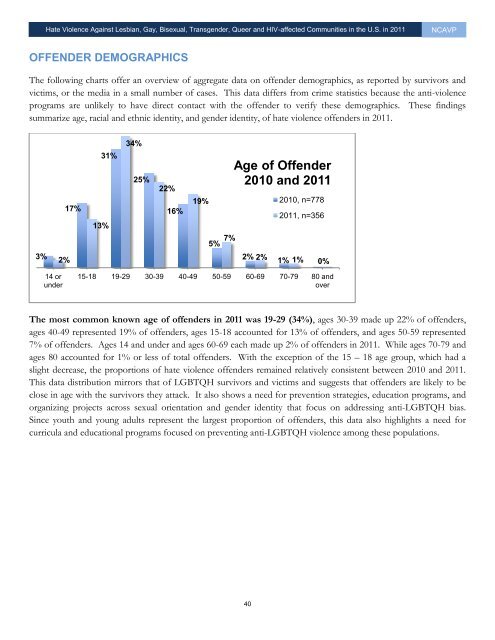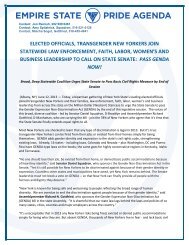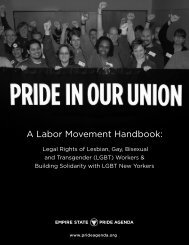Hate Violence against the Lesbian, Gay, Bisexual ... - AVP
Hate Violence against the Lesbian, Gay, Bisexual ... - AVP
Hate Violence against the Lesbian, Gay, Bisexual ... - AVP
You also want an ePaper? Increase the reach of your titles
YUMPU automatically turns print PDFs into web optimized ePapers that Google loves.
<strong>Hate</strong> <strong>Violence</strong> Against <strong>Lesbian</strong>, <strong>Gay</strong>, <strong>Bisexual</strong>, Transgender, Queer and HIV-affected Communities in <strong>the</strong> U.S. in 2011NC<strong>AVP</strong>OFFENDER DEMOGRAPHICSThe following charts offer an overview of aggregate data on offender demographics, as reported by survivors andvictims, or <strong>the</strong> media in a small number of cases. This data differs from crime statistics because <strong>the</strong> anti-violenceprograms are unlikely to have direct contact with <strong>the</strong> offender to verify <strong>the</strong>se demographics. These findingssummarize age, racial and ethnic identity, and gender identity, of hate violence offenders in 2011.34%3%2%17%13%31%25%22%16%19%5%7%Age of Offender2010 and 20112010, n=7782011, n=3562% 2%1% 1% 0%14 orunder15-18 19-29 30-39 40-49 50-59 60-69 70-79 80 andoverThe most common known age of offenders in 2011 was 19-29 (34%), ages 30-39 made up 22% of offenders,ages 40-49 represented 19% of offenders, ages 15-18 accounted for 13% of offenders, and ages 50-59 represented7% of offenders. Ages 14 and under and ages 60-69 each made up 2% of offenders in 2011. While ages 70-79 andages 80 accounted for 1% or less of total offenders. With <strong>the</strong> exception of <strong>the</strong> 15 – 18 age group, which had aslight decrease, <strong>the</strong> proportions of hate violence offenders remained relatively consistent between 2010 and 2011.This data distribution mirrors that of LGBTQH survivors and victims and suggests that offenders are likely to beclose in age with <strong>the</strong> survivors <strong>the</strong>y attack. It also shows a need for prevention strategies, education programs, andorganizing projects across sexual orientation and gender identity that focus on addressing anti-LGBTQH bias.Since youth and young adults represent <strong>the</strong> largest proportion of offenders, this data also highlights a need forcurricula and educational programs focused on preventing anti-LGBTQH violence among <strong>the</strong>se populations.40




